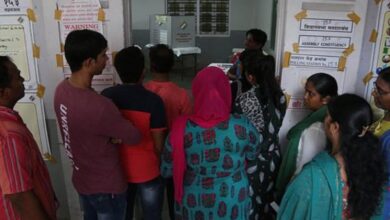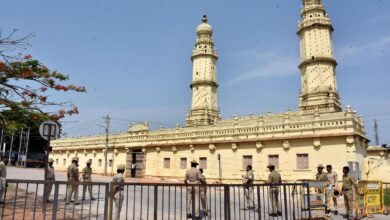J&K Assembly poll result reiterates NC’s status as guardian of Kashmiri nationalism

On the afternoon of October 10, 1996, Farooq Abdullah broke into tears as he was taking oath as the Chief Minister after seven years of militancy and political hibernation as a galaxy of political personalities of the country was present during his swearing-in ceremony. The oath of office and secrecy, which took place at Centaur Hotel on the banks of the picturesque Dal Lake, was administered by Governor Gen. K.V. Krishna Rao. Reviving politics in Jammu & Kashmir (J&K) in 1996 was seen as a national project, as thousands of political workers — particularly from the National Conference (NC) — lost their lives. The electoral activity was seen as critical to restore the faith of the people in the region, ravaged by militancy, in the democratic institutions of the country.
Almost 28 years later, in October, NC vice-president Omar Abdullah is set to be sworn in for the second time as Chief Minister of J&K. While the security situation of the region is nowhere as it was in 1996, the last six years of political changes and developments had been no less cataclysmic.

One of the largest princely States of the country before 1947 became a Union Territory, and Article 370, which was once seen as an architect of faith for the NC, a premier political party of J&K that provided popular legitimacy to accession with India, was abrogated. With this background and context, a detailed and granular decoding of the results of the elections in J&K and its implications is required, as this would leave its imprint on the overall governance of the region, Centre-J&K relations and national security.
J&K is one of the most diverse parts of the country thanks to its geographical, linguistic, ethnic and religious diversity. Starting with the Kashmir Valley, the NC-Congress-CPI(M) alliance won 41 out of 47 seats. The NC got 35 seats out of the 41, whereas the Congress won 5. This was a demonstration of the collective decision of the electorate in homogenous Kashmir Valley to defeat the BJP’s gameplan.
The fact that the BJP can never single-handedly come to power in Muslim-majority J&K is no secret. That is why the BJP’s gameplan in the 2024 elections was never hidden. This was to get substantial seats in Jammu, which had 43 seats, and then hope that the electoral verdict is divided in Kashmir Valley, which had 47 seats, as has been the case since the 2002 Assembly election.
However, surprising even the NC leadership, the electorate in the Valley, which is deeply political and sensitive to the granular nuances, owing to years of conflict and uncertainty, was quick to understand the political cues as neatly articulated by the NC leadership. Except three seats that went to the People’s Democratic Party (PDP), an Independent candidate in the Scheduled Tribe reserved seat of Shopian, Engineer Rasheed’s party and Peoples Conference leader Sajjad Lone in Handwara area of Kupwara district, the NC-led alliance swept the Kashmir Valley. This verdict once again reiterated the NC’s status as the main guardian of the fortress of Kashmiri nationalism as was proved by its founder Sheikh Abdullah for over 50 years.
While the BJP leadership was excited at the prospect of various Kashmiri Muslims lining up to get party tickets, the fact is that any party that ruled the Centre found takers in the Valley. The PDP, which was severely dismantled, could not recover from the impact of its pact with the BJP in 2014. And the fact that the PDP never apologised for the same and continued to defend it indicates it had not correctly read the mood on the streets even after a gap of nearly 10 years since the pact.

Focussed approach
That apart, the NC was better prepared organisationally. The NC cadre remained energised in the last three years as leaders continued to reach out to the far-flung areas of J&K ever since Covid-19 restrictions were removed. It was the first political party to have its manifesto in the public domain, enabling it to set an election narrative early on. It had also assigned leaders to various constituencies a year in advance, who were finally able to nurture their respective segments. In short, the focussed approach of its leadership yielded dividends.
Several candidates and parties perceived to be playing into the BJP’s gameplan, which tried to imitate the past acts of the Centre, were defeated. In 1972, Jamaat-e-Islami won five Assembly seats in the Kashmir Valley as popular leader Sheikh Abdullah boycotted the poll. Jamaat entered the political landscape but the victory was largely seen as a concession by the ruling Congress party at the Centre.
In this election, candidates who had a Jamaat background were defeated. Mr. Rasheed’s party could win only Assembly segment. This comes only a few months after the defeat of Mr. Omar Abdullah to Mr. Rasheed. The narrative that Mr. Rasheed is playing the game of the BJP became popular on the ground. Several developments such as the decision of the NIA not to oppose his bail only lent credence to these allegations. In Beerwah, the imprisoned Sarjan Ahmad Wagay finished third with 12,228 votes, whereas the NC candidate Shafi Ahmed Wani won 20,118 votes.

Much of the analysis that has accompanied the 2024 verdict boils down to the fact that electorally J&K had been divided into Hindu-majority parts of the former State and Muslim-majority Kashmiri Valley, Pir Panjal region and Chenab Valley. The growing split of J&K’s voters along religious lines, with no structural institutions to bind them together in their diversity, remains a source of perennial worry. Those who have been eyewitnesses to the three decades of conflict in the region know that a religiously polarised landscape is a powder keg for violent forces to exploit on both sides of the Pir Panjal, the mountain range that geographically divides the Valley from the Jammu region.
While the BJP won all its 29 seats in the Hindu majority segments, this binary of Hindu-Muslim electoral division does not fully capture the reality. For instance, the NC was able to win two Hindu-majority segments, namely Ramban and Nowshera. In the 1996 election, the NC, which claims itself as a pan-J&K party, had won 14 seats in Jammu and this included four Hindu-majority segments.
In 2024, it won seven seats in the Jammu region, which includes the hilly areas of Pir Panjal and Chenab Valley, where it could only get one seat. Jammu region, which is almost double the size of Kashmir Valley, is religiously diverse but there is considerable linguistic unity with the exception of a few parts of the erstwhile Doda district, now popularly known as Chenab Valley. The delimitation of segments, as expected, helped the BJP in erstwhile Doda district as it won four seats out of eight seats, including the newly carved segments, Doda west and Padder-Nagseni. The BJP was also able to win Bhaderwah and Kishtwar, the two communally sensitive segments with mixed demographics. Some of these segments such as Padder-Nagseni, Doda west and Kishtwar victory margins were small, indicating a fierce contest.
In the past, the NC had managed to create a loyal voter base among sections of Jammu Hindus, particularly the Dalits. The Dalits were beneficiaries of the NC-initiated land reforms in 1950, in which one of the central tenets was the provision of land to the tiller. Dalits comprise nearly 19.44% of the population of Jammu province. However, at the macro level, the trend of North India’s all-caste Hindu consolidation in favour of the BJP continues to trump the NC’s once-notable claim over a slice of Dalit vote bank. The BJP has secured all seven Scheduled Caste (SC) seats in Jammu for the second consecutive Assembly and its highest vote share in these polls is also largely on account of Hindu consolidation in Hindu-majority districts of Jammu province, that recorded a high voter turnout.
The Congress, which fought the bulk of the seats in Jammu as part of the alliance arrangement with the NC, won only Rajouri segment — by a mere 1,404 votes. The reasons for the success of the BJP are many and the reasons are in line with their overall national success in the realm of electoral management. First, the Congress lacked a capable human resource on the ground that could forcefully articulate its campaign narrative that could find resonance with the local people.
The BJP machinery was at work right from the day the election was announced. The party leadership was all over the region with Home Minister Amit Shah crisscrossing the region. In contrast, the local Congress leaders failed to sensitize the party leadership with the nuances of the region. For instance, Congress leader Priyanka Gandhi, addressing a public rally talked about the visit of former PM and her grandmother Indira Gandhi to Kashmir Valley in 1984 without factoring in that she was in Jammu, a widely different political landscape. She invoked Kheer Bhawani, a temple which is popular among Kashmiri Pandits in the Valley’s Ganderbal. In contrast, Prime Minister Narendra Modi, who had lived in Jammu as a political activist, referred to Vaishno Devi in Katra, a more popular shrine for Jammu Hindus and this reflected his mastery over the local nuances.
In this environment, a total of five Independents were elected. Some of them were either part of the Congress or the NC, which again reflected misjudgment over the seat allocation. Gujjar leader Mohammad Akram, the son of Congress party stalwart and former Speaker, J&K Assembly, Chowdhary Aslam won the seat as he defeated Congress candidate and his co-ethnic Mohammad Shahnawaz. Another Independent winner was Satish Sharma, son of Congress leader and former MP Madan Lal Sharma, who was elected in the border segment of Chamb. Independent Pyare Lal Sharma won in a predominantly Muslim-majority segment of Inderwal by defeating another independent G.M. Saroori, who is considered close to former Chief Minister G.N. Azad.
Mr. Sharma was a rebel NC candidate and he left the party after the party conceded the Inderwal segment to the Congress. At the same time, the BJP failed to inspire Jammu Muslims in its favour. For instance, the Pahari-speaking Muslims community, who were primary beneficiaries of the Central government’s decision to grant Scheduled Tribe status to the Pahari community, also did not vote comprehensively in their favour as it failed to win in the Pir Panjal region.

Across J&K, in the seats reserved for the ST population, the NC took six ST seats, the Congress one whereas three Independents won. Eight members of the Gujjar community, one Pahari community member and one Shinna-speaking community will now be the 10 members from the ST community in the J&K Assembly. This is not much different from the previous Assembly as political reservation to the ST community, which came after the abrogation of Article 370, as the J&K Constitution did not have a provision, did not alter the ST configuration in the J&K Assembly.
Various challenges
Meanwhile, the electoral verdict in one of the most diverse parts of the country brings its own set of challenges that have wider implications. The challenge of governance is enormous as more than 72% of the population lives in the rural areas of J&K. The former State has its own challenges as unlike other parts of India, within J&K, there is little physical infrastructure that could create sustainable, long-term economic security in the non-State sector. Bereft of statehood status, Constitutional guarantees in the area of fiscal federalism such as Article 270, Article 275 and Article 280 are not applicable to J&K. In this context, the LG office, which already controls the home portfolio, is all set to be a parallel power centre until the statehood to J&K is restored.
Coupled with this is the broader political and social context. J&K is witnessing a sharpening of religious polarisation and the voting pattern is in accordance with that trend. Progressively, parts of J&K that have a predominantly Hindu population are voting overwhelmingly for the Modi-led BJP whereas the Muslim-majority areas, including the Valley and hilly areas of Jammu province, are voting against the BJP.
Former Chief Minister G.M. Sadiq had once told a leading public intellectual from J&K that that it was easy for him to contain the entire oppositional space to three urban segments of Jammu, which invariably voted for Jan Sangh, the earlier avatar of the current BJP. Often, three or four urban segments of Jammu city, where the Civil Secretariat and government offices in the winter capital are located, become synonymous with Jammu province which has 43 seats. Over the years, as this election demonstrated, the sphere of the BJP has expanded in Jammu but it has penetrated only in Hindu-majority areas.
While Pir Panjal divides the Kashmir Valley from Jammu, the latter comprises the plains and mountainous belt. Jammu plains are Hindu-majority but the Jammu mountainous belt has diverse and mixed religious demographics as some administrative units have the majority of one particular community while the sub-units within it have majority of another community. With this delicate social equilibrium, averting inter-regional as well as inter-religious tensions will be the biggest challenge for the new governing elite. The inter-regional vector, which often acquires a communal connotation, and its wider implications on the national politics is often underestimated.

J&K has always provided the BJP an entire mosaic of issues — national security and real or perceived historic, regional and religious contestations — that are leveraged in the Hindi heartland. Some of these issues require unpacking by separating polemic from facts. The BJP’s fierce opposition to Article 370 was on account of its charge that the Article was an act of appeasement for India’s only Muslim-majority State that is now a Union Territory. The BJP avers that the former State should have acceded to the Indian Union like other princely States. The facts are somewhat complex and a number of crucial eyewitnesses are still alive to attest to that. On March 9, 2021, in a less-publicised interview on an online portal, Karan Singh, the son of the last princely ruler, Hari Singh, acknowledged that his father was “considering independence” of J&K before he signed the instrument of accession on October 26, 1947.
The death of S.P. Mukherjee, the founder of the Jana Sangh, the BJP’s earlier avatar, in Srinagar on June 23, 1953 is where the BJP began its political journey with J&K. There is hardly any discussion by a BJP parliamentarian without a reference to Mukherjee’s death in Srinagar. He was arrested as he tried to cross into J&K without a permit issued by the State government, a legal requirement for non-J&K State subjects in that era, and taken into custody at Lakhanpur at the Punjab-J&K border. Mukherjee died as a result of a heart attack in Srinagar, according to the version of the then State government. His death is often invoked as martyrdom by the BJP cadre within and outside Parliament during any discussion on Kashmir. That is why a verdict, which is being described by some quarter as the electoral split between Hindu and Muslim J&K, suits the BJP. Depending on the context, it provides greater ability to weaponise the issues linked to J&K across the country and leverage the current political landscape.
If history is a guide, giving representation in the Cabinet alone provides no assurance of inter-regional stability and harmony. Methodically studying the 1953 crisis, when the first Prime Minister of J&K, Sheikh Abdullah was arrested, and the 1984 dismissal of Chief Minister Farooq Abdullah by Governor Jagmohan Malhotra will reveal that inter-regional contestations lay at the heart of these unconstitutional acts that had enormous implications. A detailed institutional decentralised polity is one of the solutions for governing a diverse J&K. Given, this approach requires a lot of granular understanding of J&K’s and heavy-lifting on various fronts, this is a long-term project and in the present context, where the priority of the ruling political class is to get statehood back, it may not have the bandwidth for this at the moment.
At the same time, there is a greater need to reach out to the local talent and civil society actors with societal roots that have granular understanding of these issues and past trends that could inform the polity that can ensure proactive steps are taken in this regard. The worst-case scenario will be if Hindu-majority parts of Jammu gravitate towards the BJP-led Centre for addressing its regional aspirations or grievances and the Kashmir Valley or Muslim areas of Jammu towards the NC-Congress-led governing elite. Apart from putting the Congress on the defensive and in a difficult situation, because of its national stakes, this will only reinforce the electoral divide and will have disastrous consequences for the unity of J&K and its wider national security calculus.
Cross-border terror
Another factor that requires political sagacity from political elite at the Centre as well as J&K is with respect to the issue of cross-border terrorism. The recent uptick in militancy in J&K has taken place in the areas to the south of Pir Panjal that separates the Kashmir Valley from the Jammu region. The police is on record to have said that more than 100 militants are in Jammu province. The area with its heterogeneity has its own challenges as compared to Kashmir Valley. It is a lesser-known fact that militancy to the south of Pir Panjal that divides Kashmir Valley from Jammu was 35% of the total violence in J&K from 1990 to 2007. To better understand the present phase, one has to unpack the recent rise in militancy in J&K, namely the infiltration patterns, why attacks are taking place frequently, granular components of political context which are exacerbating the situation in J&K and what can be done to avert them. A bureaucratic regime is incapable of knowing and processing granular nuances rooted in the ground-level realities which require inter-disciplinary knowledge of decades.
In a way, the worsening security situation is directly linked to the centralisation of powers, which came with the abrogation of Article 370 and absence of political participation in J&K affairs. The additional presence of troops (or some will say unsustainable) in Kashmir Valley since August 5, 2019, has shored-up local intelligence that have enabled relatively quiet consecutive summers in the Valley and an end to stone-pelting. But that does not mean attacks have stopped and recruitment has ebbed in the Valley. In 2022, there were targeted assassinations, thus indicating that at any given opportunity militants will strike their targets. The BSF chief in Kashmir has recently stated that around 150 militants are waiting at launchpads across the Line of Control (LoC) to infiltrate into Kashmir. In this context, what is ideally required from the Central government is the early restoration of statehood and that will place the Unified Command, a civil-security joint apparatus on counter-terrorism in J&K established since the 1990s, under the direct control of the elected Chief Minister. This institutionalised structure of inter-agency coordination under political supervision will act as force multiplier in anti-militancy operations. In the past, elected political class, which is particularly more aware of the societal dimensions of militancy as compared to the military component, has succeeded in timely sensitising the security apparatus in this regard.
In the context of global south, the current ruling Indian political elite at the Centre scarcely leaves any global opportunity in projecting India as a country with resilient democratic institutions and traditions. J&K’s demotion from a State to a Union Territory and curtailment of civil liberties that has accompanied the abrogation of Article 370 is not in conformity with these claims and the projection. The 2024 elections for J&K Assembly comes as an opportunity to reverse this and one genuine goodwill gesture by the Centre should be the early accommodation of J&K as a full-fledged State in the Indian union by according full constitutional guarantees and protection to the people of J&K like other Indian citizens. The onus will also be on the NC-led coalition to address the prevailing challenges within J&K with maturity and sensitivity by factoring in the structural forces that have often shaped the course of J&K’s political trajectory.
Luv Puri has authored two books on J&K, including Uncovered face of militancy and Across the Line of Control.
Published – October 14, 2024 04:03 pm IST






